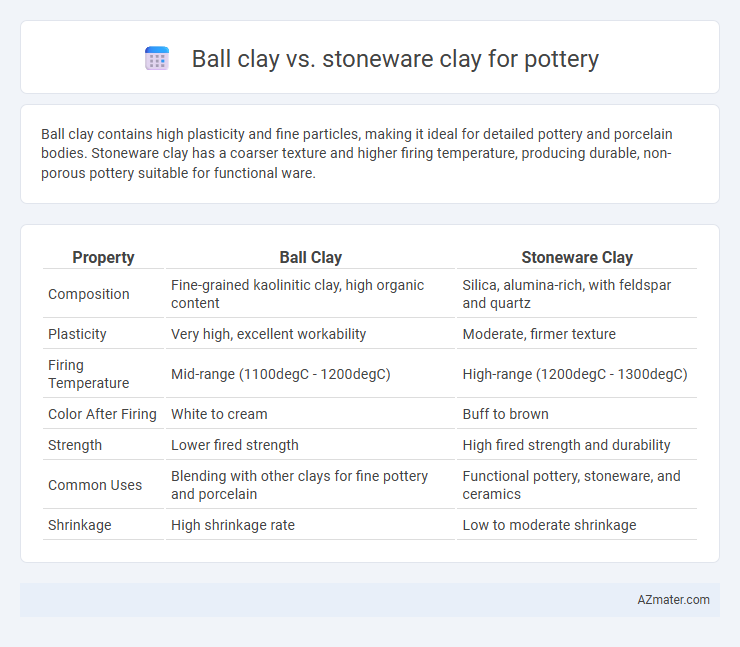Ball clay contains high plasticity and fine particles, making it ideal for detailed pottery and porcelain bodies. Stoneware clay has a coarser texture and higher firing temperature, producing durable, non-porous pottery suitable for functional ware.
Table of Comparison
| Property | Ball Clay | Stoneware Clay |
|---|---|---|
| Composition | Fine-grained kaolinitic clay, high organic content | Silica, alumina-rich, with feldspar and quartz |
| Plasticity | Very high, excellent workability | Moderate, firmer texture |
| Firing Temperature | Mid-range (1100degC - 1200degC) | High-range (1200degC - 1300degC) |
| Color After Firing | White to cream | Buff to brown |
| Strength | Lower fired strength | High fired strength and durability |
| Common Uses | Blending with other clays for fine pottery and porcelain | Functional pottery, stoneware, and ceramics |
| Shrinkage | High shrinkage rate | Low to moderate shrinkage |
Introduction to Ball Clay and Stoneware Clay
Ball clay is a fine-grained, highly plastic sedimentary clay used to enhance plasticity and strength in pottery. Stoneware clay is a durable, non-porous clay that fires at higher temperatures, producing dense, vitreous ceramic pieces ideal for functional ware. Both clays serve distinct roles in pottery, with ball clay improving workability and stoneware clay providing strength and water resistance.
Key Mineral Composition Differences
Ball clay contains high amounts of kaolinite, mica, and quartz, providing excellent plasticity and smooth texture ideal for detailed pottery work. Stoneware clay features a higher concentration of feldspar, along with kaolinite and quartz, contributing to its durability and vitrification at high firing temperatures. The mineral composition differences result in ball clay's superior workability and stoneware's strength and water resistance when fired.
Plasticity: How Each Clay Performs
Ball clay exhibits high plasticity, making it exceptionally easy to shape and ideal for detailed, intricate pottery work. Stoneware clay has moderate plasticity, providing a balance between workability and strength, suitable for functional pottery with durability. The superior plasticity of ball clay allows for finer detail but requires blending for added strength, whereas stoneware clay supports sturdier, more robust ceramic pieces.
Firing Temperature Ranges Compared
Ball clay typically fires at lower temperatures, ranging between 1100degC to 1250degC, offering a smooth texture and plasticity suitable for detailed pottery work. Stoneware clay requires higher firing temperatures, usually from 1200degC to 1300degC, resulting in a denser, more durable ceramic with increased vitrification. The choice between ball clay and stoneware clay depends on the desired strength and finish, with stoneware offering greater durability and ball clay providing ease of shaping at lower temperatures.
Impact on Color and Surface Texture
Ball clay produces a lighter, creamy color with a smooth, plastic texture due to its fine particles and high kaolin content, making it ideal for detailed work and glossy finishes. Stoneware clay fires to a range of earthy tones, from brown to gray, with a coarser texture that results in a more rustic, matte surface. The choice between ball clay and stoneware clay significantly influences the final pottery piece's color vibrancy and tactile quality.
Workability and Throwing Performance
Ball clay offers exceptional plasticity and fine particle size, making it highly workable and ideal for detailed shaping and smooth throwing performance on the potter's wheel. Stoneware clay, while less plastic than ball clay, provides greater strength and durability after firing, with moderate workability that supports robust, functional pottery pieces. Potters often blend ball clay with stoneware to enhance throwing capacity and achieve optimal balance between flexibility and structural integrity.
Strength and Durability of Finished Pieces
Ball clay is highly plastic and fine-grained, offering excellent workability but generally results in pottery with lower strength and durability compared to stoneware clay. Stoneware clay fires at higher temperatures, creating a dense, vitrified, and highly durable finished piece that resists chipping and water absorption. Pottery crafted from stoneware clay is preferred for functional items requiring robustness and longevity due to its superior strength and toughness.
Glaze Compatibility and Results
Ball clay offers high plasticity and fine particle size, making it excellent for blending with other clays to improve glaze fit and minimize defects like crazing or pinholing. Stoneware clay, known for its durability and fired hardness, typically requires glazes formulated for higher firing temperatures to achieve a smooth, glossy finish without bubbling or crawling. Both clays interact differently with glaze chemistry, with ball clay enhancing glaze adherence and stoneware supporting a more robust, vitrified surface ideal for functional pottery.
Common Uses in Pottery and Ceramics
Ball clay is commonly used in pottery and ceramics for its plasticity and smooth texture, making it ideal for wheel throwing, slip casting, and creating fine, detailed pieces like figurines and delicate tableware. Stoneware clay, notable for its durability and high firing temperature, is favored for functional pottery such as dinnerware, mugs, and stoneware bakeware that require strength and resistance to chipping. The combination of ball clay with stoneware often enhances workability while maintaining the robustness needed for everyday ceramic items.
Choosing the Right Clay for Your Project
Ball clay offers excellent plasticity and fine particle size, making it ideal for detailed pottery and intricate forms, while stoneware clay provides durability and greater strength suitable for functional ware like mugs and plates. Consider the firing temperature required; ball clay typically matures at lower temperatures, whereas stoneware clay is fired at higher temperatures for vitrification and resilience. Selecting the right clay depends on the intended use, aesthetic preference, and compatibility with your specific kiln and glaze requirements.

Infographic: Ball clay vs Stoneware clay for Pottery
 azmater.com
azmater.com